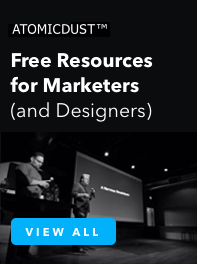The Overlooked Approach to Winning More Business: How Branding Closes Deals
Last updated: April 7, 2025
Recently, I gave a talk to a group of professional services business owners and leaders about how branding helps to close sales deals.
And while it was fresh in my head, I thought I would share some thoughts here.
In more than 20 years in business, Atomicdust has helped hundreds of businesses build, grow and steer their brands. Our clients have ranged from small startups in our early days to billion dollar companies in recent years.
But the truth is, no one hired us for pretty pictures or interesting typefaces.
Business Challenges, Investments and the Purpose of Branding
Most branding (and rebranding) projects begin with business challenges. Maybe it’s competition, lead generation or launching a new product. But there is always an underlying business reason for the investment.
And I say investment because that is what building a brand is. It takes time, money and energy. And like all investments, businesses expect a positive return.
Now, the soft part is that the return on investment isn’t always measured in money. It can be measured in customer loyalty, market recognition or just being known in your space as the market leader.
You can scoff at the ‘soft’ results of branding and argue that the only real measure of value is bottom-line revenue, and in that context, you would be correct. But don’t underestimate the soft benefits.
They are the very things that lead to bottom-line revenue.
Impacting the Qualities of Leads
Let me take a minute to explain how the Atomicdust brand helps us with sales leads, saving us time and money.
Through our inbound marketing, our website drives a lot of interest and sales leads. And from that, there are usually two types of clients that approach us for projects:
1) Relationship-Based Leads: People who have heard of us and are excited about talking to us about a project.
2) Price-Based Leads: People who don’t know us and really just want to know the price.
That first scenario is way, way easier to close. The sales process is more of a formality. We have an inside track. They aren’t talking to anyone else. The proposal is more of a conversation.
The second is hell. They are talking to six other agencies. They want free work. They want us to present who we are in a predetermined format that isn’t us at all. They want to compare our pricing to see who is the lowest. Everything being equal, we have a 16% chance of winning.
And that’s why a professional services company’s brand is essential.
Brand as Reputation
Branding dramatically impacts the qualities of leads. It helps companies get a lot more of that first type of lead. Why? Because brand is reputation.
Remember, famed author Marty Neumeier says, “A brand is a person’s gut feeling about a product or service.” Think of brand and reputation as the same thing.
Brand-ing is the attempt to shape that feeling.
Put another way, branding is intentionally deciding who your customer is and how you help them, and then continually reminding them of that fit.
Branding is Foundation and Growth
Branding is made up of two parts: Foundation and Growth.
Foundation Elements
Foundation is made up of things like audience profiles, brand positioning, brand language, logos, websites, presentations—things that don’t change that much over time.
Growth Strategy
Growth is about the message you promote, the frequency of timing and the channels you use. Social media, advertising, speaking, writing, PR, events, content, SEO, email marketing, trade shows, etc. Think about growth as the everyday marketing stuff.
Companies need both if they want to have an easier time closing the deal.
Branding in the Sales Process
Most B2B professional services companies face the same problems.
First, they don’t know where their next project is coming from.
They often compete against multiple other firms in the RFP process, their brand isn’t positioned that uniquely and the client commands the sales process. It can all lead to unpaid proposals, unpaid work and lower fees.
If the client’s ‘gut feeling’ is that all the firms are very similar, it will line them all up against each other and look for the lowest price.
This is the worst place you can be. Famed business strategist Michael Porter calls this “the dreaded middle.” It’s when you’re not the cheapest or the most different.
Ideally, a firm’s brand is positioned and known (or even loved) by the client. In those cases, the firm can skip the RFP process, have an advantage or win with higher fees.
There is a natural conflict in the sales process. The goal of the customer is to remove all the emotion from the buying process. The goal of branding is to make that impossible.
The entire purpose of branding is to eliminate your competition in the first place—before the sales process begins.
The Importance of Branding
A lot of professional services firms don’t realize how much of an impact branding has on sales.
But focusing on a strong brand, for both foundation and growth, has major ROI.
The return comes in different forms, and might be hard to measure. But ultimately, branding helps businesses get more leads, and better leads. Closing deals with those leads gets infinitely easier.
According to recent industry studies, companies with strong, consistent branding see up to 33% higher revenue growth compared to those with inconsistent or weak branding. What’s more, they command premium pricing—on average 13% higher than competitors.
FAQ: Branding and Sales
How long does it take to see ROI from branding investments?
While some immediate benefits may be visible, meaningful ROI typically emerges over 6-18 months as your brand positioning takes hold in the marketplace. The most successful brands commit to consistency over time.
How do I measure the impact of branding on our sales process?
Track metrics like lead quality scores, sales cycle length, win rates, and proposal-to-close ratios. Also monitor the number of times you’re competing against others versus being approached as the only solution.
Is branding still relevant in a digital-first business environment?
More than ever. In a digital landscape where potential clients research solutions before ever contacting you, your brand positioning is often making the first impression and pre-qualifying leads without your direct involvement.
What’s the most common branding mistake professional services firms make?
Looking and sounding like everyone else in their industry. Generic positioning leads to commodity pricing. The firms that thrive are those willing to stake out a distinctive position, even if it means not appealing to everyone.
So if you’re looking to grow sales and close more deals, take a step back and focus on your brand.



